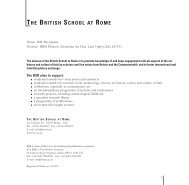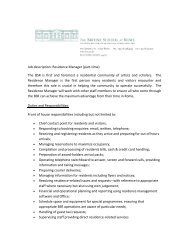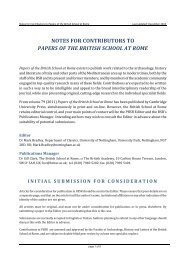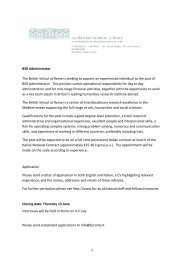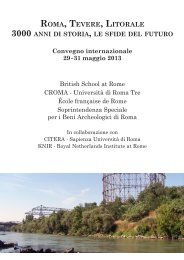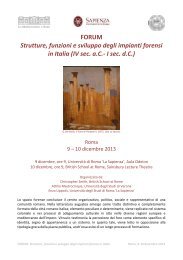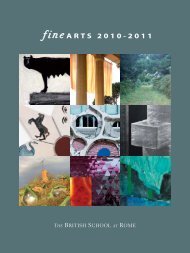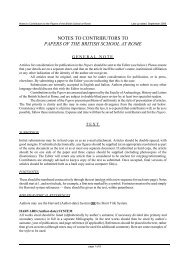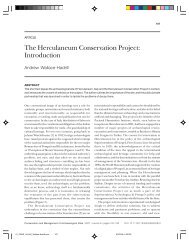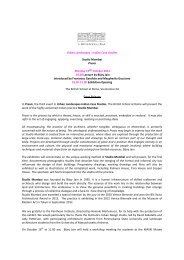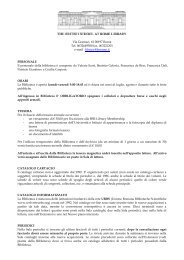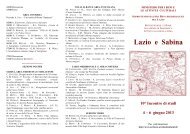Annual Report 2008-9 - The British School at Rome
Annual Report 2008-9 - The British School at Rome
Annual Report 2008-9 - The British School at Rome
Create successful ePaper yourself
Turn your PDF publications into a flip-book with our unique Google optimized e-Paper software.
H ERCULANEUM C ONSERVATION P ROJECT<br />
<strong>The</strong> major project <strong>at</strong> Herculaneum initi<strong>at</strong>ed by the<br />
Packard Humanities Institute, and put into effect by<br />
the <strong>British</strong> <strong>School</strong>, in close collabor<strong>at</strong>ion with the<br />
Archaeological Superintendency (which now reunites<br />
Pompeii with Naples), is now in its eighth year of activity.<br />
Advances can be reported on two principal fronts. <strong>The</strong><br />
first is in the campaign to address the problems of the<br />
infrastructure of the site and bring the movement of w<strong>at</strong>er<br />
under control. As roofs are progressively repaired, and the<br />
ancient drainage network put back into action, so the<br />
problems mount <strong>at</strong> the lowest point of the site, where in<br />
antiquity the town came down to the sea. A major project<br />
of clearing and draining the ancient shoreline has led to a<br />
series of important results. Dram<strong>at</strong>ic evidence accumul<strong>at</strong>es<br />
of how severely the buildings — especially the Suburban<br />
B<strong>at</strong>hs, which were built out to meet the shoreline <strong>at</strong> a<br />
period when the sea had retre<strong>at</strong>ed — were l<strong>at</strong>er damaged<br />
as the land rose and the sea returned. This is the result of<br />
the phenomenon called bradyseism whereby the earth’s<br />
crust rises and falls in the build-up to an eruption. <strong>The</strong><br />
most unexpected find has been the remains of the<br />
collapsed roof of a nearby building, tossed by the force of<br />
the firestorm of a pyroclastic surge to the beach down<br />
below. It is possible from this find to reconstruct the<br />
entire carpentry of a Roman roof, including its woodpanelled<br />
ceiling.<br />
<strong>The</strong> second principal area of work has been on the<br />
north-western edge of the site, were preliminary work is<br />
underway to assess the possibilities of new excav<strong>at</strong>ion of<br />
the Basilica. A georadar survey by the BSR/Archaeological<br />
Prospection Services Southampton team gave impressive<br />
but r<strong>at</strong>her impenetrable results. Reopening the Bourbon<br />
tunnels has cast a flood of light. <strong>The</strong> old tunnels are more<br />
numerous and complex than anyone had imagined, a<br />
veritable rabbit-warren; the pottery left behind in the<br />
backfill suggests people had been exploring long before the<br />
official start of excav<strong>at</strong>ions under the Bourbons in 1738. A<br />
rich harvest of other finds includes some fragmentary<br />
inscriptions and the gemstone from a signet. <strong>The</strong> walls of<br />
the tunnels have exposed some rich fresco-work. <strong>The</strong> most<br />
impressive find, however, came not from this area, but<br />
from the western edge of the town, where our team were<br />
giving assistance: a brilliant insight by Mimmo Esposito led<br />
to the discovery of a fine ‘neo-Attic’ marble relief.<br />
<strong>The</strong> project has involved increasingly close collabor<strong>at</strong>ion<br />
with the personnel of the Soprintendenza, especially the site<br />
director, Maria Paola Guidobaldi, and above all the<br />
Soprintendente himself, Piero Guzzo. Without his vision,<br />
courage and determin<strong>at</strong>ion, this project could never have<br />
happened, and he will be sorely missed on his retirement<br />
this September. We are also indebted to the Comune of<br />
Ercolano, and its Mayor, Nino Daniele, for enthusiastically<br />
embracing the project, and promoting the new Intern<strong>at</strong>ional<br />
Study Centre to bring about closer links between the<br />
intern<strong>at</strong>ional world of specialists and visitors and the local<br />
community. Work is now finished on the restor<strong>at</strong>ion of the<br />
Villa Maiuri, where the previous study centre, named after<br />
the gre<strong>at</strong> archaeologist Amedeo Maiuri, had its se<strong>at</strong>; and we<br />
look forward to moving into these new premises in the<br />
autumn. Our warmest thanks go to the Mayor and his staff,<br />
to the Soprintendenza, to the tireless members of the<br />
project team led by Jane Thompson, and above all to David<br />
and Pam Packard, without whose enthusiasm and support<br />
there would literally be no project.<br />
Andrew Wallace-Hadrill<br />
Director, Herculaneum Conserv<strong>at</strong>ion Project<br />
11



